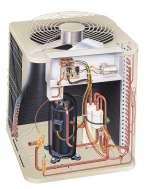Dear Jim: My old heating and A/C system must be replaced. With energy cost volatility, how can I determine which type of fuel (oil, gas, propane, electric, etc.) is best to go with? -- Johnnie T.
Dear Johnnie: It can make economic, environmental and life-style sense to switch to an entirely different type of heating source for your home. The costs of fuels, such as natural gas, propane, heating oil, electricity, etc., have been changing dramatically relative to one another. Electricity prices seem to be the most stable lately.
Among conventional central, geothermal heat pumps often provide the highest efficiency and lowest year-round utility bills. The drawback is the higher initial installation costs due to the plumbing through the ground. Even with the expiration of the federal energy tax credit, it still can make good economic sense. Some states still offer tax credits.
The primary advantage of installing any heat pump is it is used year-round for both heating and cooling. This makes its higher initial cost economically feasible because of the year-round savings. A super-efficient furnace is used only during winter and a central air conditioner only during summer so they provide savings only during their seasons.
Hybrid heating systems are becoming more popular today. These combine a fossil-fuel, such as an oil, gas or propane, furnace with a heat pump instead of a central air conditioner. The heat pump is energy efficient for heating during mild weather and then the furnace kicks in when it gets cold. From an environmental standpoint, this also is better.
Even though electric resistance heating is expensive to operate, infloor radiant heating systems can be efficient. With the improved comfort with heat from the floor, it is possible to set the thermostat lower and save overall. WarmlyYours Company makes radiant systems that can even be used under carpeting.
Also consider alternative heating systems, such as firewood, coal, wood pellets, and corn. Many of these heating systems are becoming more user-friendly than and almost as convenient to use as a standard gas furnace or heat pump. They can be controlled from a wall thermostat and have automatic ignition when heat is needed. Dual-fuel wood-burning furnaces automatically switch to gas or oil when the wood burns down over night.
I use a geothermal heat pump in my home along with a wood-burning fireplace and a pellet/corn stove for hybrid heating. During very cold periods, I run the pellet stove continuously to heat an area of my home where I spend the most time. The wood-burning fireplace provides more intense heat, but takes a while to heat up in the morning.
Pellet/corn stoves require maintenance, basically cleaning, every month or so. The advantage is you can do the service yourself so there is no cost. Since they do not use a chimney as a fireplace does, a regular visit from a chimney sweep is not needed.
To compare the cost to use various systems of your home, use the following heat contents:

* natural gas -- 1,025 Btu/cubic foot
* oil -- 138,700 Btu/gallon
* propane -- 91,000 Btu/gallon
* electricity -- 3,414 Btu/kilowatt-hour
* firewood -- 22,000,000 Btu/cord
* corn -- 448,000 Btu/bushel.
Divide the cost per Btu by the system efficiency to get the actual operating cost comparison.
Once you have determined the operating costs of various systems, consider other intangible factors. Every system requires maintenance which can increase the overall costs. For fossil fuels, an oil furnace requires more service than a gas furnace because oil does not burn as cleanly and it is a more complex design. A heat pump requires about the same amount of service as an air conditioner.
Dear Jim: I was at my home center store and saw some "water-saving" faucet aerators that screw on the end of the faucet. How do they save water if I am filling a pot or the sink? -- Eileen M.
Dear Eileen: You make a good point. Aerators save water by mixing air with the water for a forceful flow using less water. If you are filling a container with water, however, it just takes longer and saves no water.
The savings are realized when you are washing your hands, dishes, etc. For these activities, the length of time that the water is on will be the same with or without the aerator. With the aerator, 50 percent less water will be used.
Send inquiries to James Dulley, Lincoln Journal Star, 6906 Royalgreen Dr., Cincinnati, OH 45244 or visit www.dulley.com.
0 CommentsLove0Funny0Wow0Sad0Angry0For the holidays: Get inspiring home and gift ideas – sign up now!
* I understand and agree that registration on or use of this site constitutes agreement to its user agreement and privacy policy.








